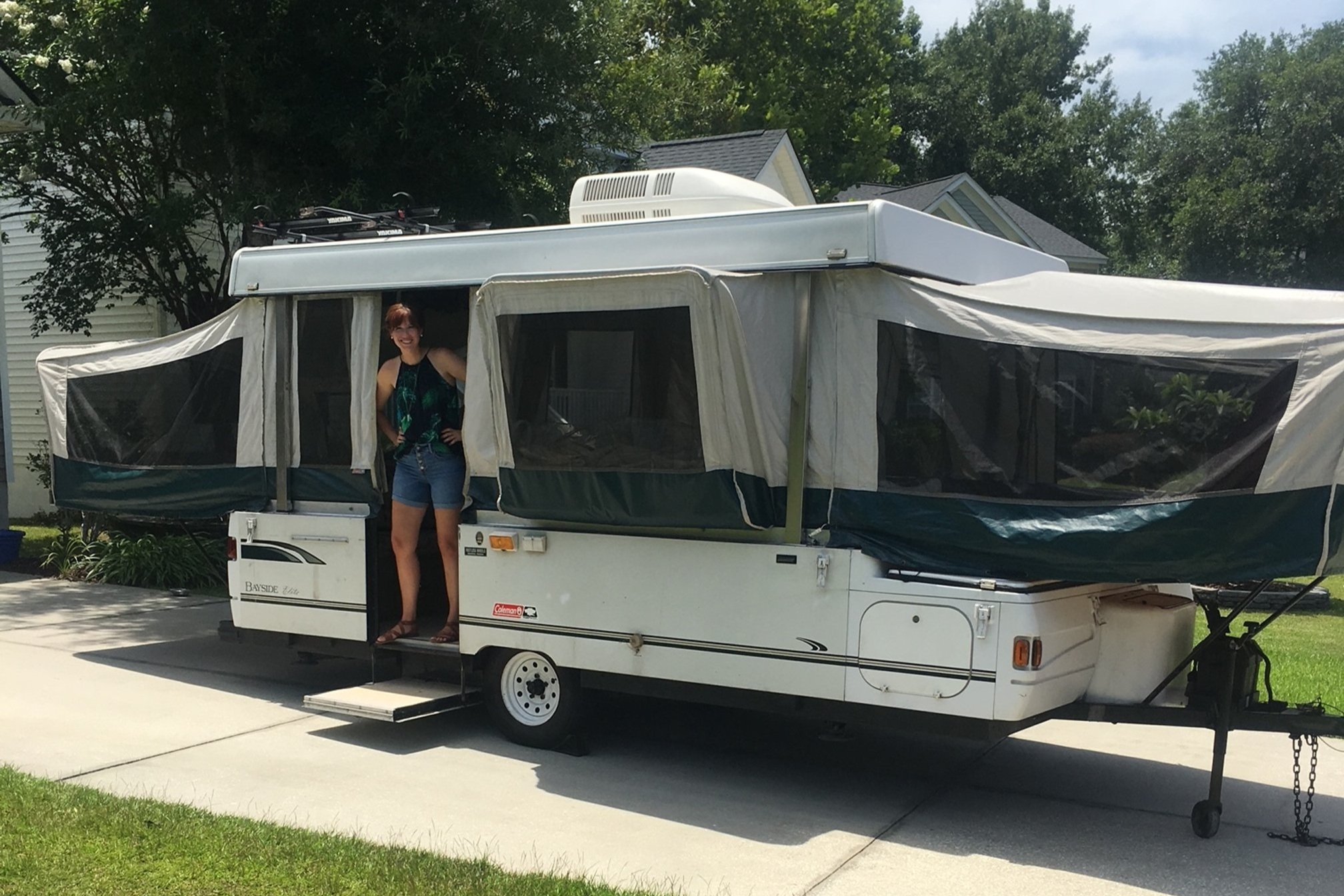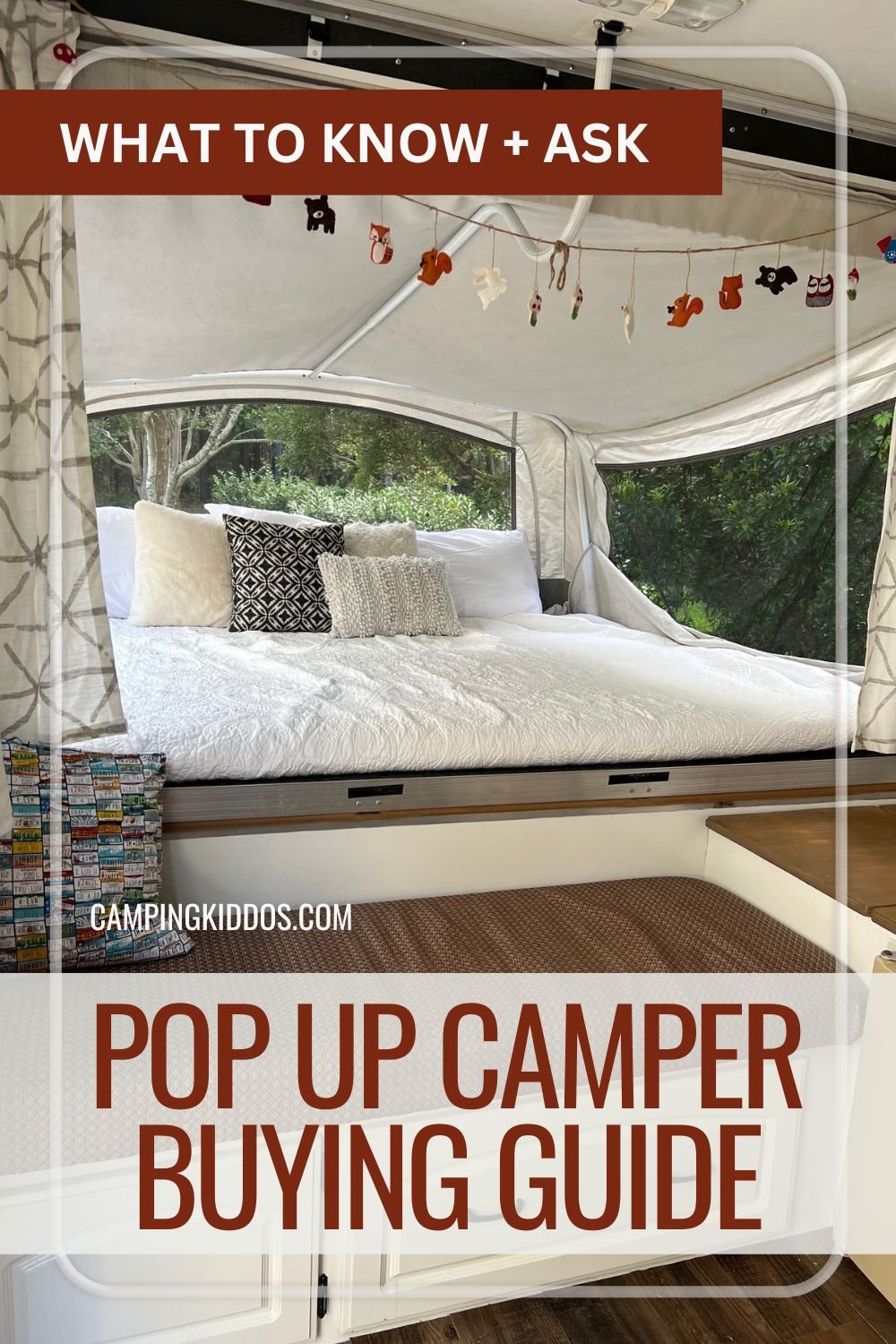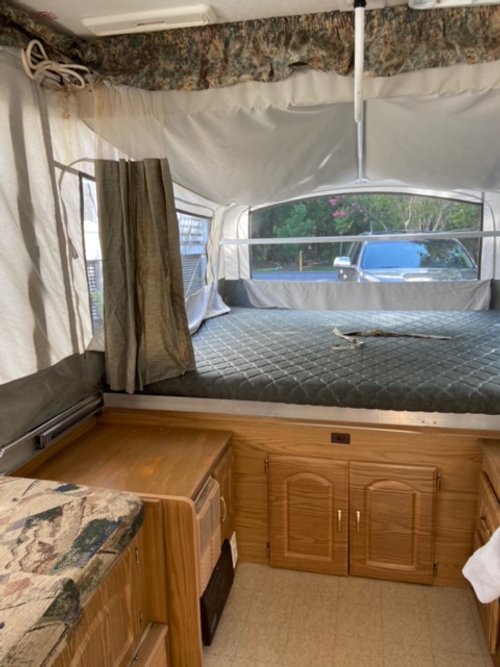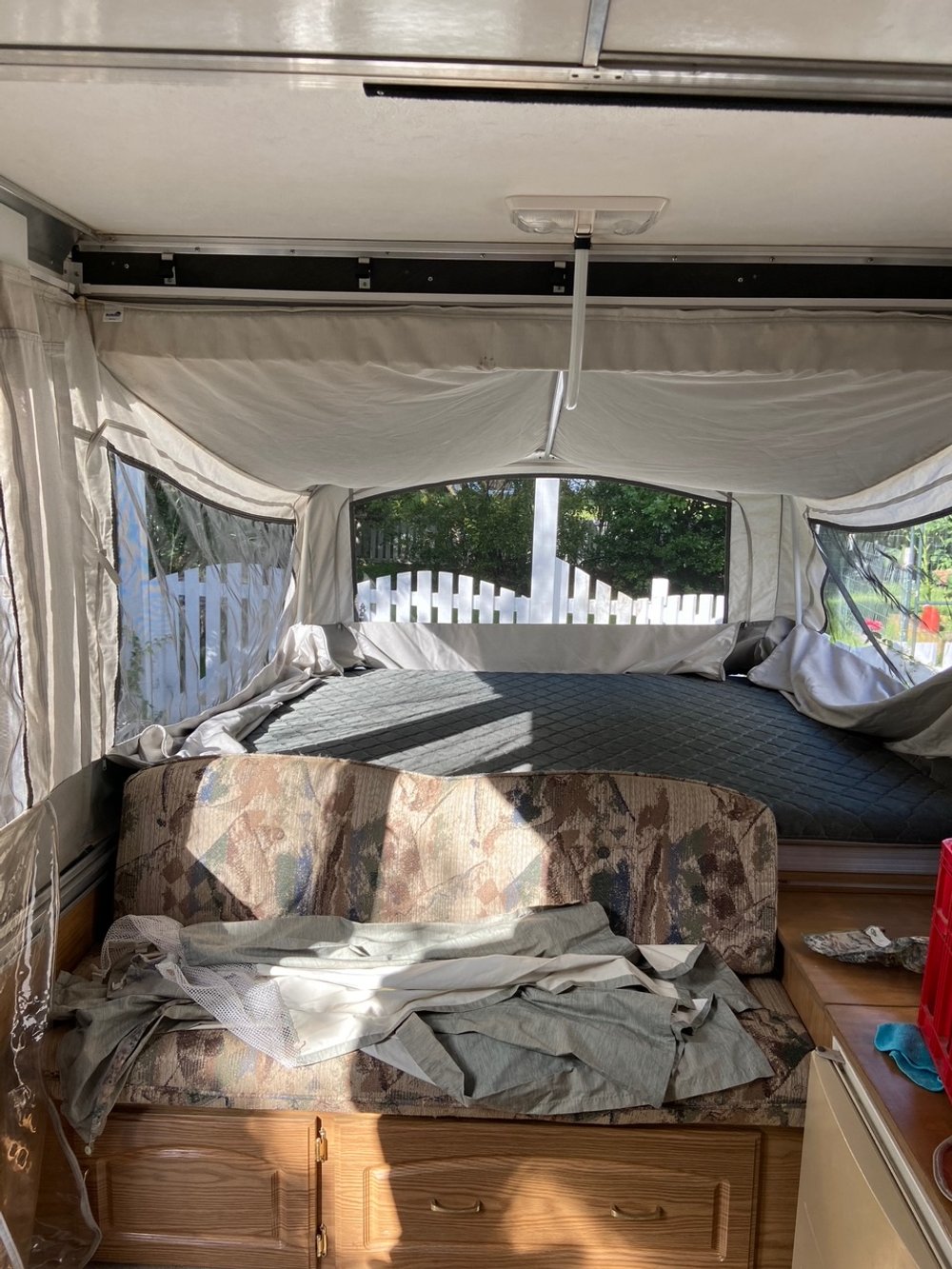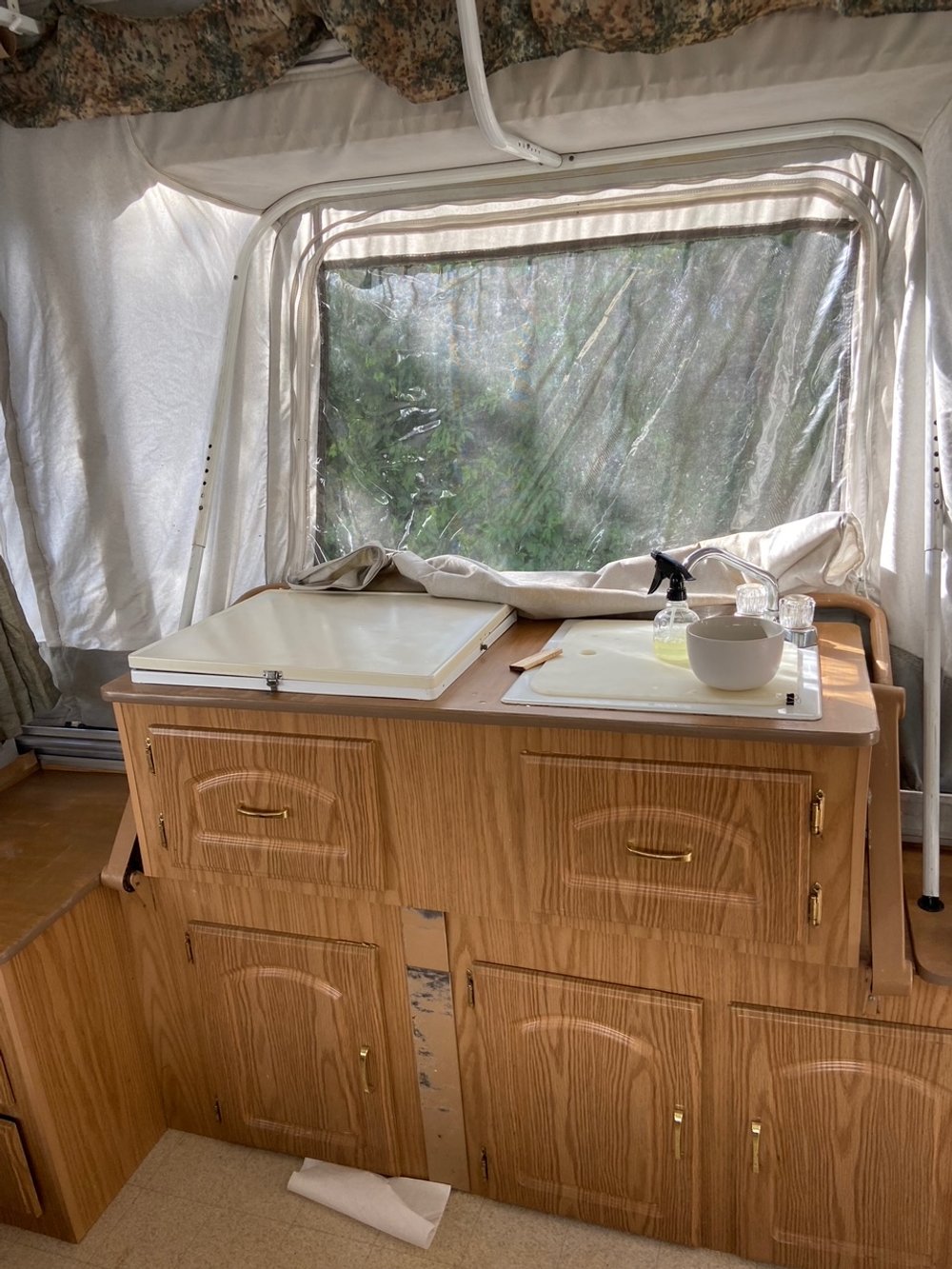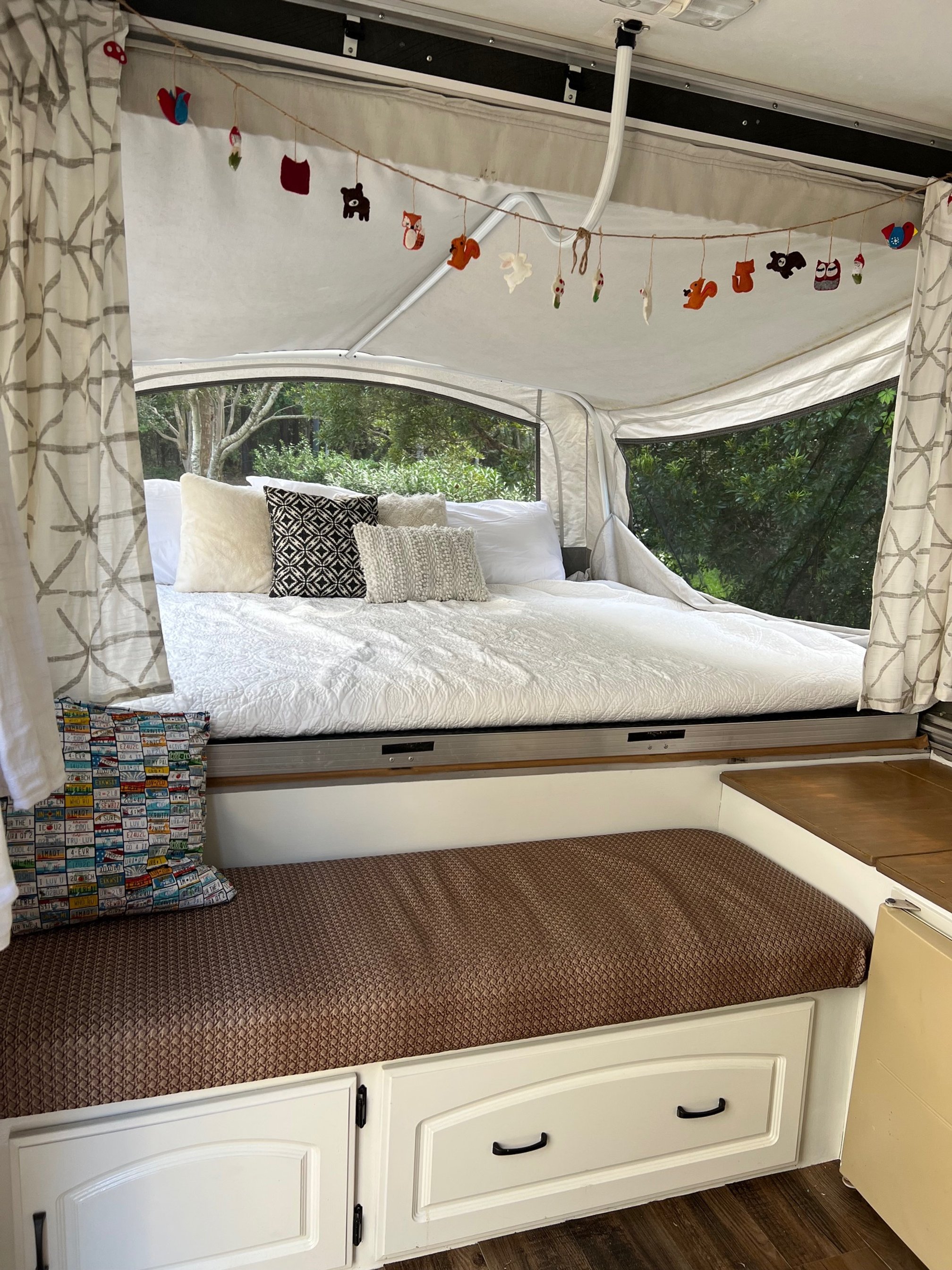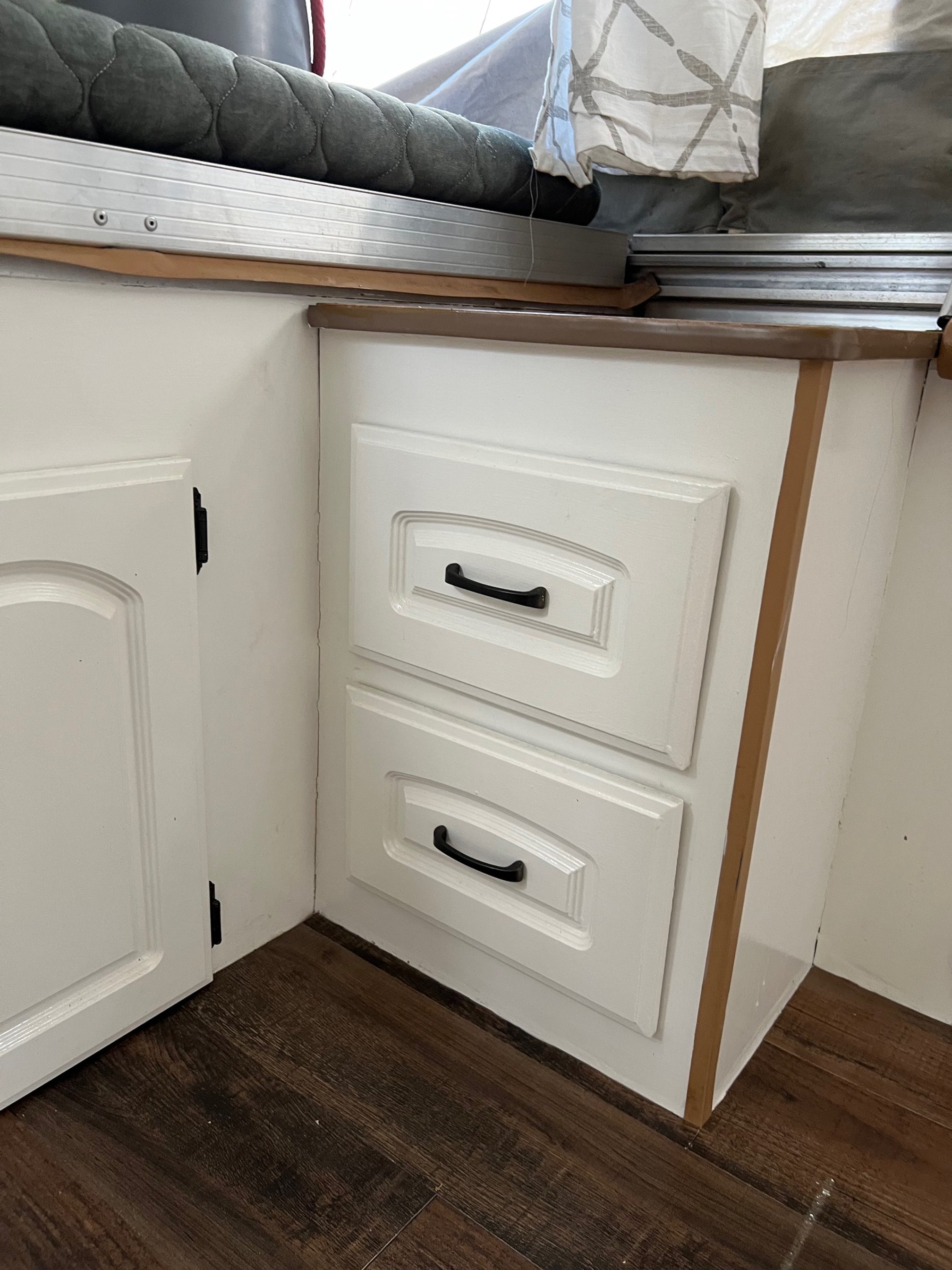Pop Up Camper Buying Guide
This helpful pop up camper buying guide will walk you through everything you need to know to make an informed purchase for your family.
Pop up travel trailers are so much fun if you’re looking for an upgrade to tent camping, but it’s important to understand what’s typical for these types of campers.
When we first bought our pop up camper, I was nervous as it was our first non-tent camping venture.
But, thanks to a lot of research and the help of other pop up camper owners, we ended up with a solid camper that we made some incredible memories in!
Below, you’ll find everything you need to confidently assess and purchase a pop up camper.
While it’s particularly important to use these tips when you’re buying a used camper, you should also be thorough when looking at new pop up campers, too.
The author standing in the doorway of her pop up camper
This post contains affiliates. If you purchase through the links below, I will receive a commission at no additional charge to you.
Typical Features of a Pop Up Camper
Pop up campers come in a wide variety of styles.
We had a standard older pop-up, a Coleman Bayside, which looked just like the pop up camper you have in your head. It had the canvas sides with a bed at each end. Up until about 3 years ago, my parents also had a similar style pop-up, though theirs was a bit newer than mine.
Twinning with my parents’ pop up (in the background) in Pigeon Forge
Today, my parents have a unique type of pop-up camper by Trail Manor that is completely hard sided when it is assembled.
To muddle the waters even more, some pop-ups have an A-frame shape, though the overall mechanics work the same as the more traditional rectangular pop-ups. Some of these are hard sided while others have a canvas topper.
Despite these potential differences, all pop-ups work essentially the same.
First of all, they’re much, much simplier than your standard full sized travel trailer or RV. This learning curve is what initially drew us to the pop-up.
We wanted something that felt like a natural progression from tent camping, so that we could spend more time adventuring and less time worrying about the bells and whistles.
Here are the basics you’re likely to find on your pop-up camper.
Lift system
No matter what type of pop up trailer you have, you’ve got to have some way to unfurl the camper and then repackage it for the return trip home.
These lift systems work internally to bring up the skeleton of the camper from its compact box into the livable space that you’ll need to enjoy your vacation.
Old school campers like ours will have a manual crank that slowly lifts the cords and metal tubing into place.
Newer campers will have an electrical system to help you with this process, and that is worth paying for in my opinion.
There’s nothing like driving for hours and then having to manually crank up your pop up in the summer heat. Opt for the electrical system if at all possible.
Even if you do have an electrical system, make sure that you know how to use the back-up crank, as every newer pop-up will have this, too. Your camper should come with a metal manual crank that will work to raise or lower the top if you lack electricity or the electrical system stops working.
Pull out bed(s)
Your camper will have at least one bed, but mostly likely will have 2.
The tiniest pop-up campers only have 1 double or queen bed, but I’ve noticed that these are only found in the older camper models and the A-line campers.
Most pop up campers are going to have a bed that pulls out on either end of the camper: one that will go over the hitch, and the other that will go over the back bumper.
The size of these beds depends on your overall camper width, but you can find them typically in queen and king sized mattresses.
The interior of our pop up camper after I renovated it
Our pop up camper had 2 king sized mattresses, which was great since our kids shared one end of the camper.
NOTE: In the traditional camper lay outs, the dinette can also be transformed into another, smaller bed if you need sleeping space for a 5th person.
Kitchen
Pop up campers also have a small kitchen area, typically with a small propane stove, sink, and mini fridge.
While we tended to use our portable outdoor grill, it is nice to have extra cooking space inside of the camper.
We’d use the interior cooking area to prep and warm up side dishes while the main entree was being prepared on the outside grill.
It’s also nice on rainy or chilly days if you’re quickly making some soup, oatmeal, or the like.
Our kitchen was small (as all of the pop up camper kitchens are), but we still had enough counter space for a coffee pot. My parents used their extra counter space for a microwave, which provided even more quick meal, beverage, and snack options.
In their current pop up, the Trail Manor, my parents have much more storage and counter space, so that’s a consideration for the soft- vs. hard-sided pop up campers.
Dinette
Your pop up will also have a dinette or dining space somewhere in the layout.
Our pop-up had a slide out on the driver’s side, and this area held the dinette. The table was small and similar to a card table in that it had folding legs. It was flanked on 2 sides by bench seating.
Other pop up campers have the dinette in front of one of the beds. This configuration allows for U-style seating, providing you with more space overall.
In either case, you’re not going to have a ton of room here, and we often found ourselves eating outside whenever possible.
But, the interior eating space is great for early morning cereal and fruit when everyone’s still waking up.
We’ve also made use of it on more than one rainy day when no one wanted to go out of the camper.
Front storage
PIN ME!
Generally, you’ll have a nice sized storage area underneath the front bed, which is great for storing brooms, beach chairs, cleaning supplies, and tools.
This compartment typically has a door on the exterior of the camper and on the interior, making it easy to grab items no matter where you are.
Some campers come with even more storage, like a weatherproof box on the tongue of the trailer.
Our pop up had this extra exterior storage, and it was great for holding beach toys, chocks, leveling equipment, and other travel trailer must haves.
Optional: bathroom area
Whether to buy a pop-up camper with a bathroom or one without was the biggest decision we had to make in our search.
Since we were upgrading from tent camping, we were no strangers to using campground bath houses (or the woods!), so we weren’t sure if we wanted the additional stress that comes along with learning about sewer hook-ups, black tanks, and the like.
We ultimately opted to get a camper without a bathroom set-up, and, honestly, I never missed it.
We did have tiny kids for our time with our pop-up camper, so we used a Luggable Loo with trash bags and kitty litter lining for any middle-of-the-night emergencies. (This was honestly an upgrade from what we had tent camping!)
For anything other than that, we made sure to get a spot close to the bath house so we had easy access to the showers and toilets.
My parents’ 2 pop up campers have both had bathrooms, so we’ve been able to see the layouts both with and without.
If you do choose a layout with a bathroom, keep in mind that the showers are tiny, and you’ll have to stand very near or over the toilet to use it.
The kids’ bikes on the roof rack ready to go!
7 Questions to Ask when Buying a New Pop Up Camper
So, you’re headed to your local camper dealership, and you want to look at some pop-ups.
While it’s tempting to assume that a brand new camper will be perfect right off the lot, the reality is more complicated than that.
As with any big purchase, you want to do your due diligence, and inspect your camper from tip to toe.
Here are the basics to start with to see if a specific model will work for your family.
1. How large are the fresh, grey, and black tanks?
There’s no right or wrong answer here, just whatever with work with your family’s needs and camping style.
If you plan to always camp in a campground with water and sewer hook-ups, the exact sizing of these tanks doesn’t matter as much as if you’re going to do a lot of boondocking.
On average, look for tanks that are 25-35 gallons each. You can boondock with a family of 4 for 2-4 days depending on your water usage.
2. Does this come with a warranty?
While warranties come with their own set of questions, it’s good to know right off the bat if you have that option to fall back onto.
Many new campers do come with some sort of limited warranty, so you’ll want to have your sales associate go over those terms carefully.
If your camper is a new model left over from a previous year that didn’t sell, ask if a warranty can be added, and, if so, what it will cover.
3. How quickly can I set up the pop up camper?
This is a HUGE item to focus on that I didn’t consider when we bought our camper.
Camping at Cherokee KOA in North Carolina
However, it’s important to consider that you don’t just arrive at a camping spot out of nowhere.
Instead, you’re likely tired from getting up early to pack and then driving several hours. Your kids will want to run around in the campground.
The last thing you want to do is fiddle with a pop-up camper for an hour.
My husband and I would time ourselves to see how quickly we could put up and break down the camper. 17 minutes was the record, but we were also having to use our manual crank system, which slowed us down.
If you’re buying a new pop up, look for one that has as easy of a set up and break down as possible, and ask the sales clerk to let you try the process before you buy.
4. How long is the pop up camper?
Most pop up campers will fit just about anywhere, but it’s important to know the length for a few reasons.
The first is due to the fact that you may want to store it in your garage. Typically, a camper about than 19’-21’ is going to fit in a standard garage, but longer ones might cause the garage door not to close.
Knowing if the camper will fit is especially important if you live in a neighborhood with an HOA or if you’re planning to store the camper in a storage space that charges by the size.
The second reason to know the length of your camper is based on where you’ll want to do your camping.
National parks are notorious about having tiny spots that only short travel trailers, pop ups, and Class B RVs can fit into. Going shorter in your pop up is recommended if you think you’ll be camping in a lot of national parks.
In general, the smaller your trailer, the more campsites you’ll be able to stay in. This goes from KOAs to state parks.
Of course, the smaller you go, the less room you’ll have, so it’s a toss-up on your family’s needs.
5. Does it run off of electric or propane (or both)?
Most campers use both electric and propane, but it’s good to know from the start which systems run off of which type.
In both our pop up camper and our existing Winnebago Micro Minnie 1800BH trailer, the electricity (on both the shore power and the solar power) runs the water heater, the air conditioning, and the lights, while the propane fuels the stove and the heat.
6. What type of amperage does it use?
Your pop up will run off of either 20 amps, 30 amps, or 50 amps.
We’ve found that 30 and 50 amp hookups are the most common, but we will run into the occasional 20 amp.
Knowing what type of amperage your travel trailer runs off of will help you determine what campgrounds you can visit.
NOTE: If you end up with a 30 amp, remember to buy a 30-to-50 amp pigtail for conversion!
7. How heavy is the camper?
Possibly the most pressing question, you need to know what your new camper weighs so you can compare that to the GWVR (gross vehicle weight rating) of your potential tow vehicle.
Your vehicle’s GWVR should include EVERYTHING you plan to pack in the camper and not just the camper’s dry weight.
For example, our pop up was around 3700 pounds dry weight, but once we added bikes, coolers, bedding, clothing, pool toys, tools, beach chairs, a grill, and the like, it could easily be around 4500 pounds.
Our pop up camper before the renovation (and just after we bought it)
Our camper after the renovation:
10 Questions to Ask when Buying a Used Pop Up Camper
If you’ve decided to purchase an older camper, welcome to the club!
Older campers often still have plenty of life left in them, and you might be able to get a great price.
Another pro for buying a used pop-up is that any issues that exist have already shown themselves, and, often, the owner will have fixed these for you—or can at least tell you where to start.
Finally, we opted for a used pop up camper because the individual features of a pop up change very little from year to year.
If you’re purchasing a used pop up camper, you’re likely buying on a second hand market from an individual rather than from a camper dealership.
Here’s what to ask to ensure the you’re getting a great camper in the transaction.
1. Has there been any water damage?
Nothing strikes fear into the heart of any camper owner like the idea of water damage.
Lots of things on a camper can be fixed, but a soft roof or floors can spell disaster.
Inquire about any water damage and if the roof has ever been resealed.
Properly repaired water damage isn’t necessarily a deal breaker, but you will want to know what happened and how it was fixed.
Having an older camper means that you’ll also want to know when the roof was resealed. If it hasn’t ever been resealed, check for water intrusion and make plans to reseal as soon as your transaction is complete.
As a follow-up question, you should also ask: did you always dry the camper before you put it up?
While it’s nearly impossible to avoid putting up the camper in the rain during the life of your camper, it’s essential to then let the camper dry out as soon as you get home.
Campers that haven’t been put up dry (even when there isn’t any other water damage) can have a musty smell.
We had to change out those tires almost immediately after buying them.
2. When was the last time that the tires were changed?
When I first got my pop up camper, my dad spotted the tires and immediately dubbed the “may pop tires” (meaning, they may pop at any time!)
Since pop up campers tend to run on really inexpensive 13” tires, you’re going to want to be fanatical about when the tires were replaced.
Try the penny trick: using a penny, place the coin upside down in the grooves of your tire treads. If Lincoln’s head is covered, the tires still have a hearty tread. If you can see Lincoln’s head, it’s time to replace them.
You’ll want to ensure that you have excellent tread on your pop up tires at any point (including the spare!) as this will reduce the possibility of the tires malfunctioning on your next trip.
I will warn you: when those inexpensive 13” tires are done, they are DONE.
On our Outer Banks vacation, I had not one but both tires implode, one on the way there, and one on the way back. Both were in good shape, treadwise, so I don’t know what happened—perhaps I picked up a nail or hit a rough patch in the road, or simply had bad luck?
The second tire exploded rather than slowly deflated, tearing a hole into the undercarriage of my pop-up and making a huge mess.
Thankfully, I had 2 new spare tires and I was able to get back on the road quickly.
Because of this experience, I want you to be vigilante about the tires that come on your used pop-up. Even if the seller says they’re new, it doesn’t hurt to change them out.
3. How often did you use the camper?
Campers like seeing the world.
You don’t want a camper that’s been hanging out in someone’s backyard for the last 5 years.
Those rarely-used campers, even when they’re covered or in a garage, are much more likely to have mold, mildew, dry rot, and electrical problems.
Plus, if there are any issues with camper, how would the owner even know?
Unless you’re prepared to take on a major renovation project, skip the cheap-o camper on Facebook that’s been hanging out for years. Pay a little more for the camper that’s been regularly used and maintained.
4. Do you have a clean title?
While this requirement varies from state to state, in general, it is important to have a clean title to your camper.
In South Carolina, my home state, you don’t need a title for your camper if you’re staying in the state at all times.
However, the minute you roll outside state lines, you need to have a title.
You’ll want to check your own state’s requirements—and that of your insurance company—to determine title expectations.
It’s also worth it to see how difficult it is to replace a title if it has been lost.
As a follow up question, ask: how many other owners has it had?
While a multi-owner situation isn’t a bad thing, it’s good to know when and where the trailer has exchanged hands.
5. Is there any damage to the tent/ canvas portion?
Our camper at Lakewood Camping Resort in Myrtle Beach, South Carolina
A pop-up camper isn’t particularly complicated: at its most basic, it’s a trailer with a box built onto it, and a canvas tent perched on top.
That being said, if you need to make a repair on the pop up anywhere, you hope that it’s on the box portion and not the canvas.
This is because the canvas is extremely tough and not something you can casually fix like you might a shirt.
Smaller rips might be able to be patched with a kit, but anything larger than a couple of inches means major work.
Serious tears in the canvas portion usually means that you’ll have to take the entire tent off and send it to a company for repairs.
Alternatively, you can have a new canvas tent made for your specific trailer make and model.
Either way, these tent repairs aren’t cheap or quick (some can take up to 6 months to mail in and get back!), so they’re worth considering if you’re looking at a fixer upper-type of pop up camper that will need a new tent.
6. What upgrades did you make?
While upgrades to an older pop up camper can breathe new life into it, you’ll still want to be choosy about who did those upgrades as well as when they were done.
If the upgrades were largely cosmetic—painting cabinets, adding new wooden floors, updating the curtains, etc.—you’re likely fine as these don’t have anything to do with the structural integrity of the trailer.
However, if the seller tells you that he or she has completely rewired the electrical system to now do X or Y, I’d ask questions (and a lot of them).
First of all, you’ll want to make sure that the seller knew what he or she was doing, and that those upgrades aren’t actually a hazard.
Secondly, you’ll then need to test the upgrades to ensure they’re actually upgrades and not more of headache.
When in doubt, walk away. Major system upgrades done by someone unfamiliar with those systems can break or make it harder for an actual repair person to fix the damage.
7. What type of amperage does it use?
Just as I noted in the new pop up camper questions above you’ll want to do your due diligence on the used camper’s amperage requirements.
It’s important to know this information with any camper, but this is also a good time to ask the seller if the camper has ever had any issues with the electrical system and hookups.
Pull out the camper’s electrical hook-up and examine it. Are there any signs of melted plastic or deformed prongs? If so, these could indicate past issues with the electrical hookups—and a higher risk of fire or arcing.
8. What is the GVWR?
To repeat myself again from the new pop up camper questions, you ALWAYS want to do your research when it comes to towing your camper—you should be familiar with both the dry weight with nothing in the camper and the maximum weight that your tow vehicle can safely pull.
You’ll need to check with your car or truck manufacturer’s manual to determine the GVWR, and with the camper’s handbook to determine dry weight.
If your seller doesn’t have the camper handbook, the dry weight is often included on a placard or sticker somewhere on the exterior of the camper.
Overloading your camper and/or your tow vehicle can be disastrous, so proceed with caution and knowledge.
9. Are there any issues with the heating/cooling systems?
With a pop-up, you’re likely to have issues in 2 places: the tent upper or the A/C.
The tent can easily tear what with the constant up and down of the pop up, and RV air conditioning units go through a lot on the road.
The A/C units easily freeze over and have trouble keeping the campers cool. After all, if you’re camping in 95 degree heat, that poor A/C unit is going to be working overtime in that porous tent to keep the interior cooler than about 85 in midday.
A/C units in disrepair can also drip (or pour) water onto the roof and canvas, both of which aren’t great.
Carefully look at the pop-up camper’s ceiling for signs of water damage—rippling in the wood or plastic material of the roof, darker areas on the ceiling and floor, or buckling on the floor.
While previous water damage isn’t unilaterally terrifying, you will want to proceed with caution. Some water damage that was quickly addressed by the seller isn’t bad, but ongoing or prolonged damage can warp your camper and invite mold.
10. How is the lift system?
Finally, let’s talk about the system that keeps the entire pop up camper going: the lift system.
At it’s most basic, the lift system works to pull the camper ceiling from its traveling position into the air so that you can make use of the camper while at the campground.
Without a working lift system, your camper is nothing more than a heavy box on wheels, so having a reliable and well maintained lift system is crucial.
In older models, the lift system works using a series of pulleys and rope or wire that are placed inside the 4 metal support posts. When you manually crank up the ceiling, you’re engaging these interior ropes or wires that then help you left the ceiling in place.
The pro to having an older model is that you don’t need to hook up to electricity to set up the camper.
The con to this model that the ropes and wires can and do wear out, which means you will no longer be able to set up the camper. And that’s an expensive fix when they pop or wear out.
Newer models work through electricity and hydraulics, which are more reliable and less likely to break.
However, without electricity hookups, you're back to hand cranking the ceiling up, which is longer and harder. This limits your boondocking options unless you have a small generator.
The pro to the newer systems is that it’s impossible to overcrank or snap the raising and lowering equipment since they don’t use the older ropes or wires.
Final Thoughts on Buying a Pop Up Camper
Buying a pop up camper can be incredibly exciting, especially when you know you’re getting a great deal on a model that will work for you and your family.
I remember when we first purchased our pop up: I was out in the yard trying to set it up as soon as we brought it home. And I was booking our first camping trip an hour later!
If the pop up you’re shopping for is your first camper, give yourself grace as you get more comfortable on asking questions of the seller, whether that’s an individual or a dealership.
Do your research about newer vs. older pop up campers, and go into the search process knowing generally what model years you’d like and how much those typically go for. This will give you negotiating power when you find the right one.
Finally, don’t be afraid to walk away if anything about the transaction or the camper itself doesn’t feel or look right. There’s always another camper, and it’s better to walk away from a transaction than it is to get stuck with something that doesn’t work, needs too many repairs, or is out of your budget.

